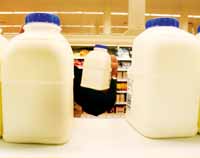Challenging times for dairy farmers

Barely has 2011 started and already we’ve seen extreme flooding in Australia, food riots in parts of Africa and the cost of oil returning to more than $100 a barrel. Consumers are bracing themselves for significant price increases in the cost of food.
The knock-on effect is being seen in the dairy sector, with the cost of purchased concentrate moving to an all-time high. With prices likely to increase to well over £200/t, and this representing more than 40% of the cost of production in many dairy systems, pressure on margins has never been greater.
And with the global demand for grain outstripping supply, we’re unlikely to see much easing in concentrate raw material prices for at least six months, and more likely 18 months before there is any significant shift. Global milk prices are likely to continue to increase, with economies such as India helping to support the demand for dairy products.
So how will the UK dairy industry respond to this? Currently there appears to be a gap of 2p/litre between the average cost of production and the average milk price received by farmers. However, the spread of milk price is still great, with those on some dedicated supermarket contracts receiving more than 28p/litre, but others getting less than 24p/litre.
Feed rates have grown over the past decade from 0.3kg/litre to more than 0.33kg/litre (Promar Milkminder data), prompted by a move for more marginal litres with the cost of quota no longer providing a constraint.
The production of quality forage, be it grazed or conserved, is likely to be further up the agenda for many dairy farmers, with the drive for marginal litres a cow lessened. Add this to the increasing number of herd sales and we’re likely to see UK milk production drop during 2012.
So with UK milk output dropping, will it be enough to stimulate a 10% increase in milk price in the UK? Why, with the global demand for dairy products increasing, is the UK’s milk price not increasing at the same pace as on the continent? Mainly perhaps due to the fact we don’t work in a perfect market. We know the balance of power lies further down the food chain, dominated by a small number of operators, both processing and marketing to the end consumer.
Ultimately, milk prices are only likely to increase when we become more effective at influencing the market. If we are to really lobby effectively, we need greater engagement with the end user of dairy products – the UK consumer. This needs to be more than just political rhetoric. If we are really to help educate consumers then we need to communicate with them at local level. We need to change the face of the UK dairy farmer from one perceived to be wanting subsidies, to one wanting to invest in a business that supports the environment and animal welfare, while developing a profitable business, employing local staff and sustaining the rural economy.
Opportunities for UK dairy farmers will exist as the industry dynamic continues to change, but overall 2011 is likely to provide a challenging environment for many.
